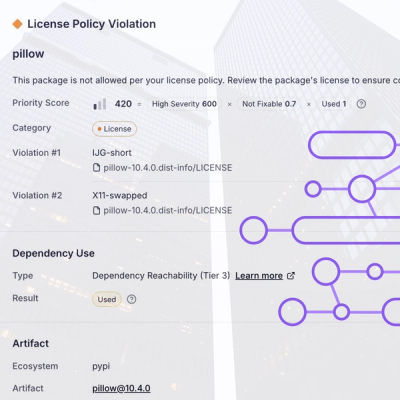
Research
/Security News
Critical Vulnerability in NestJS Devtools: Localhost RCE via Sandbox Escape
A flawed sandbox in @nestjs/devtools-integration lets attackers run code on your machine via CSRF, leading to full Remote Code Execution (RCE).
vite-plugin-vue-layouts
Advanced tools
Router based layout for Vue 3 applications using Vite
This works best along with the vite-plugin-pages.
Layouts are stored in the /src/layouts folder by default and are standard Vue components with a <router-view></router-view> in the template.
Pages without a layout specified use default.vue for their layout.
You can use route blocks to allow each page to determine its layout. The block below in a page will look for /src/layouts/users.vue for its layout.
See the Vitesse starter template for a working example.
<route lang="yaml">
meta:
layout: users
</route>
Install Layouts:
$ npm install -D vite-plugin-vue-layouts
Add to your vite.config.js:
import Vue from '@vitejs/plugin-vue';
import Pages from 'vite-plugin-pages';
import Layouts from 'vite-plugin-vue-layouts';
export default {
plugins: [Vue(), Pages(), Layouts()],
};
In main.ts, you need to add a few lines to import the generated code and setup the layouts.
import { createRouter } from 'vue-router'
import { setupLayouts } from 'virtual:generated-layouts'
import generatedRoutes from '~pages'
const routes = setupLayouts(generatedRoutes)
const router = createRouter({
// ...
routes,
});
import { createRouter } from 'vue-router/auto'
import { setupLayouts } from 'virtual:generated-layouts'
const router = createRouter({
// ...
extendRoutes: (routes) => setupLayouts(routes),
})
If you want type definition of virtual:generated-layouts, add vite-plugin-vue-layouts/client to compilerOptions.types of your tsconfig:
{
"compilerOptions": {
"types": ["vite-plugin-vue-layouts/client"]
}
}
interface UserOptions {
layoutsDirs?: string | string[]
pagesDir?: string
exclude: string[]
defaultLayout?: string
}
To use custom configuration, pass your options to Layouts when instantiating the plugin:
// vite.config.js
import Layouts from 'vite-plugin-vue-layouts';
export default {
plugins: [
Layouts({
layoutsDirs: 'src/mylayouts',
pagesDir: 'src/pages',
defaultLayout: 'myDefault'
}),
],
};
Relative path to the layouts directory. Supports globs. All .vue files in this folder are imported async into the generated code.
Can also be an array of layout dirs
Can use ** to support scenarios like module1/layouts and modules2/layouts with a setting of src/**/layouts
Any files named __*__.vue will be excluded, and you can specify any additional exclusions with the exclude option
Default: 'src/layouts'
Defines the pages dir to avoid HMR reloading for all added or deleted files anywhere in the projet.
Relative path to the pages directory. If you want it to watch for all files, like in v0.8.0 or earlier, set to null.
Can also be an array of layout dirs or use ** glob patterns
Default: 'src/pages'
setupLayouts transforms the original router by
children property.Simply put, layouts are nested routes with the same path.
Before:
router: [ page1, page2, page3 ]
After setupLayouts():
router: [
layoutA: page1,
layoutB: page2,
layoutA: page3,
]
That means you have the full flexibility of the vue-router API at your disposal.
Layouts and Transitions work as expected and explained in the vue-router docs only as long as Component changes on each route. So if you want a transition between pages with the same layout and a different layout, you have to mutate :key on <component> (for a detailed example, see the vue docs about transitions between elements).
App.vue
<template>
<router-view v-slot="{ Component, route }">
<transition name="slide">
<component :is="Component" :key="route" />
</transition>
</router-view>
</template>
Now Vue will always trigger a transition if you change the route.
If you want to send data down from the layout to the page, use props
<router-view foo="bar" />
If you want to set state in your page and do something with it in your layout, add additional properties to a route's meta property. Doing so only works if you know the state at build-time.
You can use the <route> block if you work with vite-plugin-pages.
In page.vue:
<template><div>Content</div></template>
<route lang="yaml">
meta:
layout: default
bgColor: yellow
</route>
Now you can read bgColor in layout.vue:
<script setup>
import { useRouter } from 'vue-router'
</script>
<template>
<div :style="`background: ${useRouter().currentRoute.value.meta.bgColor};`">
<router-view />
</div>
</template>
If you need to set bgColor dynamically at run-time, you can use custom events.
Emit the event in page.vue:
<script setup>
import { defineEmit } from 'vue'
const emit = defineEmit(['setColor'])
if (2 + 2 === 4)
emit('setColor', 'green')
else
emit('setColor', 'red')
</script>
Listen for setColor custom-event in layout.vue:
<script setup>
import { ref } from 'vue'
const bgColor = ref('yellow')
const setBg = (color) => {
bgColor.value = color
}
</script>
<template>
<main :style="`background: ${bgColor};`">
<router-view @set-color="setBg" />
</main>
</template>
The clientSideLayout uses a simpler virtual file + glob import scheme, This means that its hmr is faster and more accurate, but also more limited
// vite.config.js
import { ClientSideLayout } from 'vite-plugin-vue-layouts'
export default {
plugins: [
ClientSideLayout({
layoutsDir: 'src/mylayouts', // default to 'src/layouts'
defaultLayout: 'myDefault', // default to 'default', no need '.vue'
importMode: 'sync' // The default will automatically detect -> ssg is sync,other is async
}),
],
};
v0.10.0...v0.11.0
FAQs
Router based layout plugin for Vite and Vue
The npm package vite-plugin-vue-layouts receives a total of 52,937 weekly downloads. As such, vite-plugin-vue-layouts popularity was classified as popular.
We found that vite-plugin-vue-layouts demonstrated a not healthy version release cadence and project activity because the last version was released a year ago. It has 2 open source maintainers collaborating on the project.
Did you know?

Socket for GitHub automatically highlights issues in each pull request and monitors the health of all your open source dependencies. Discover the contents of your packages and block harmful activity before you install or update your dependencies.

Research
/Security News
A flawed sandbox in @nestjs/devtools-integration lets attackers run code on your machine via CSRF, leading to full Remote Code Execution (RCE).

Product
Customize license detection with Socket’s new license overlays: gain control, reduce noise, and handle edge cases with precision.

Product
Socket now supports Rust and Cargo, offering package search for all users and experimental SBOM generation for enterprise projects.